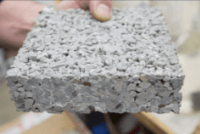Next-generation materials are those that hold promise for step-change impacts in the economic, engineering, and environmental performance of materials across their entire life cycle. Materials innovations can occur at many different scales, including: improved structural properties at the nanometer scale, novel surface geometries at the micrometer scale, and creation of new materials markets and applications at the global scale. Key examples include lightweight metal alloys and composites for more fuel-efficient vehicles, net-shape additive manufacturing for reduced material and time waste, advanced surface coatings and geometries for improved materials durability and performance and bio-derived materials for higher material and environmental sustainability.
 |
LIGHTWEIGHT MATERIALS Aluminum, titanium, and magnesium alloys, carbon and glass fiber reinforced epoxy composites and metallic and composite foams currently used only in niche, high-value products will increasingly find applications in high-volume production. This penetration will only be enabled by increased sophistication in design and simulation of hybrid structures for performance, safety and durability. These structures will likely contain many types of material—each of which has been optimized geometrically, mechanically and in other ways— will be manufactured using faster, scalable multi-material joining and assembly processes. |
 |
COMPOSITE MATERIALS While composites encompass a wide range of matrix/reinforcement combinations, fiber-reinforced polymer (FRP) composites will be targeted due to their high-performance characteristics and broad industrial applications. These lightweight composites enable energy savings in applications where large amounts of energy use and carbon emissions occur in the use phase, such as fuel savings in lighter-weight vehicles. In addition, high strength, corrosion resistant and lightweight composite materials provide benefits in diverse applications including industrial equipment and components, pipelines, structural materials for buildings, fly-wheels for energy storage, shipping containers and aerospace. |
 |
HIGH-PERFORMANCE STRUCTURAL MATERIALS High-performance structural materials offer a broad range of opportunities across metals, polymers, ceramics, and composites that improve strength and engineering performance in various applications, potentially leading to both energy and economic benefits. An example of the benefits of high-performance materials in this category include the advancements in the development of novel substitute materials for producing cement (one of the world’s largest-volume materials), including magnesium silicates or carbonates, and/or carbon-cycling processes, which can reduce or eliminate greenhouse gas (GHG) emissions from calcining. |
 |
MATERIALS FOR ADDITIVE MANUFACTURING Additive manufacturing (AM), the process of producing objects from computer-aided design model data, typically by adding layer upon layer, is projected to exert a profound impact on manufacturing, with new design flexibility, reduced energy use, and shorter time to market. Interest in AM techniques has grown swiftly as applications have progressed from rapid prototyping to the production of end-use products. However, there are still several key technical challenges for AM to successfully address in order to achieve a wider range of applications, such as: process control, tolerances, finish, scalability, speed, energy requirements, materials compatibility, validation and demonstration, and modeling. |
 |
FUNCTIONAL AND “SMART” MATERIALS Functional and “smart” materials encompass all material types. These include inorganic, organic, hybrid and nano materials, soft matter and interfaces with specific functions. This category also includes adaptive materials which are used in sensors, actuators and memory- and energy-harvesting technologies; these materials show a strong response to smaller stimuli. Electronic materials also fall into this category; they include semiconductors, dielectrics, ferroelectrics, half metals and superconductors. Finally, magnetic materials used in the creation and distribution of electricity and optical materials used in the construction of lenses, mirrors, windows, prisms polarizers, detectors and modulators fall under this area of research focus. |
 |
BIO-DERIVED MATERIALS An approach to circumvent the problems of materials that are increasingly difficult to dispose of, or are found in limited natural supply, is to replace them with materials derived from sustainable sources or that will be readily bio-degraded after use. Due to their inferior properties, the design of bio-derived composites will require more finesse and know-how than their petrochemical counterparts counterparts, such as: improvements in matrix and fiber property and reproducibility, understanding of the interfacial design between fiber and matrix, integration into hybrid structures with conventional materials, and environmental stability such as fire resistance. |
 |
BIOMATERIALS Growing life expectancy and rapid advances in replacement and transplant surgery have led to a huge increase in implantable medical devices in the last decade. Nonetheless, enormous potential remains for the impact of novel materials in the biomedical and healthcare market. Combinations of approaches in implantable devices will be enabled by AM techniques. And 3D printing will be used to combine bioactive tissue or bone scaffolds designed for each patient with a controlled-release active molecular therapy embedded in or coated over the entire structure. |